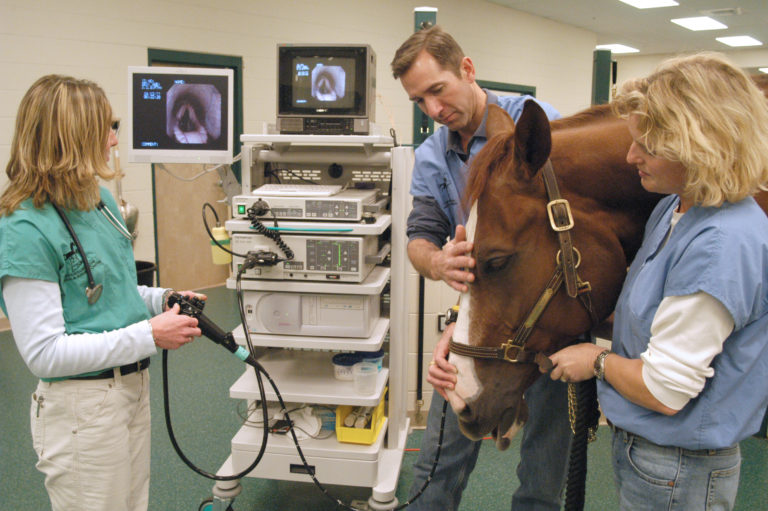Germany has always held a certain allure for me, but it wasn’t until more recently that this country of dazzling dressage horses, rich history and beautiful scenery seemed to beckon more loudly from across the ocean. I’ve been hearing about Germany—in and out of the dressage world—for as long as I can remember. At the dinner table, my granny and grandpa, the first generation of their German families to be born in America, still converse in a Texas twang peppered with household German. To this day, my grandpa proudly shares tales of visits to his own parents’ homeland, where he traced the footsteps of our ancestors.
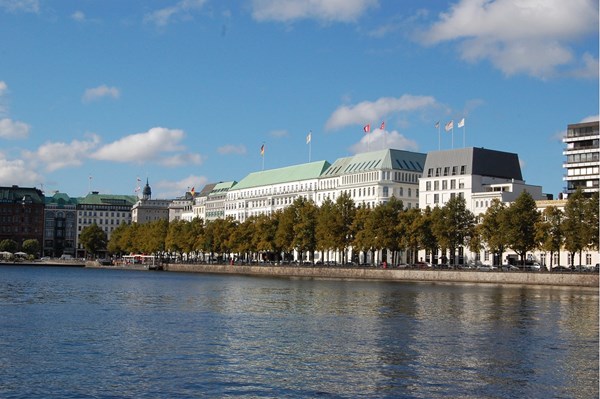
Growing up in the horse world, I learned early on that Germany is a mecca of elite dressage. Of course, gems of horses and riders can be found in every country, but Germany really stands out as a hotbed of activity that, time and time again, produces some of the best dressage horses and riders in the world. Naturally, I developed a serious itch to experience it for myself. After reading about legendary riders and hearing about famous destinations like Warendorf and the sport-horse auctions at Verden, how could I not want to see it with my own eyes?
So with permission from the rest of the Dressage Today team, I got the once-in-a-lifetime opportunity to do just that—to pack my suitcase for a month and see anything and everything relating to equestrian culture in Germany that I could. The journey was daunting yet thrilling and it was an experience that surely changed me for the better. In the following pages, I give you a look into equestrian life in Germany, exploring everything from local riding stables and world-class show facilities to the home bases of dressage icons to tack shops, saddle makers and helmet manufacturers. If you haven’t yet made the pilgrimage to Germany yourself, you might soon find your curiosity piqued.
Landing in Hamburg
My month-long adventure in Germany began in Hamburg, a port city in the north that is connected to the North Sea by the Elbe River. I arrived in the morning, after a red-eye flight and although I was exhausted from lack of sleep on the plane, I felt exhilarated the moment I set foot on German soil.
The 20-minute cab ride from the airport to my hotel, which was located very close to the city center, was a great introduction to the city. It didn’t take long for me to gather that Hamburg is a lush, green city bustling with activity. It has well-shaded bike paths that receive quite a bit of use, is buzzing with traffic and is surrounded by sparkling bodies of water. Like most European cities, anything you could need is just a short walk away. There are plenty of parks, restaurants and shopping opportunities and for being as large a city as it is, it feels very safe and comfortable. I spent my first day just walking through the city on foot, and my favorite points to explore were the areas around the town hall and the footpath around the Außenalster (Outer Alster Lake).
The following day, I took a taxi to visit my DT colleague, Annie Morris, whose name you might recognize from her training articles and blog. She had the opportunity to spend half a year working and training with Judy Allmeling and Sven Dapper, two very-skilled dressage riders who have also contributed to the magazine. Judy and Sven are based at Hof Börnsen, a dressage training and sales barn owned by Karen Klemt, located just outside of Hamburg.
Hof Börnsen looks exactly as I imagined a German dressage barn to be. It is situated in a quiet neighborhood and just oozes character. The barn itself is very old, but has had a few extensions added to it over the years. I learned that German laws are very restrictive when it comes to modifying historic buildings and due to these requirements, the layout of the barn is very unique. You’ll find lots of tight turns and nooks and crannies. Walking from the barn to the indoor arena, I passed a small tack shop, a few homes, a round pen and an outdoor ring. Plenty of turnout in large fields was visible in the distance. The indoor arena was light, bright and airy and the vaulted wooden ceilings made it feel more like a cathedral than a riding ring. The footing looked like it was made of clouds.


I learned two important lessons during my visit with Annie, Judy and Sven. As we watched Sven school one of the horses, Judy explained that he made a very solid Prix St. Georges and Intermediaire horse, but he had no future at Grand Prix. I imagined that back in the States many riders would have considered him a Grand Prix prospect without hesitation. It became clear how high the standards are for Grand Prix horses in Germany. Of course, Germany is a well-oiled machine when it comes to producing dressage horses, so it makes sense that their depth of horseflesh allows this.
Secondly, I gained a new appreciation for the American Dream as it applies to dressage. Judy explained that moving up through the competitive ranks in Germany is much more difficult than in the United States because of the way that the competition systems are designed. No matter where you are, being a successful dressage rider is never easy or simple, but Judy explained that in the U.S. it is possible for anyone who has the resources to buy a horse who has been trained to the top levels and compete at that level herself, even if she hasn’t necessarily put in much time competing at the lower levels. In Germany, it simply isn’t possible to reach the top that quickly. Horses and riders are required to receive a certain number of scores and placings at each level before they move up. But achieving a certain placing is made even harder purely by the number of entries per class. She said that it’s not uncommon for one single class to include 35 riders, and even local shows can have 1,000 horses and riders competing. Because of that, in Germany, having the goal of riding at Grand Prix is particularly difficult to reach.
There are benefits and disadvantages to each system, but as I have learned more about their way of doing things, it certainly has helped me understand why the country produces some of the most successful dressage competitors in the world. I was so thankful to Annie, Judy, Sven and Karen for sharing their farm with me and teaching me so much.
Verden: The 133rd Elite Sport Horse Auctions
The next stop on my trip was a visit to the town of Verden, home of the Hannoveraner (Hanoverian) Verband and the Elite Sport Horse Auctions. Verden is a quaint, charming town that feels quite small, especially compared to Hamburg. Verden is about an hour’s drive from Hamburg, but I opted to take the train, which was also quick and easy. My hotel and the train station were both in walking distance of the Niederschsenhalle, the location of the auctions.
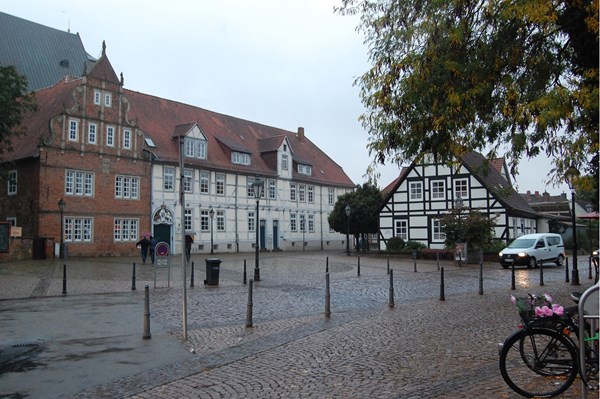
The horse auctions in Germany are fascinating and are vastly different from our idea of horse auctions in the U.S. Not surprisingly, they have it all down to a science. The horses offered for sale have been at the facility for months, where prospective buyers can visit and test-ride them. The horses are vetted (complete with x-rays) by reputable vets and their medical records are available for prospective buyers and their vets as well. They have several international representatives available, so language barriers are not typically an issue. Photos and videos are also available and they show a live-stream for international buyers to watch if they cannot be physically present.

On day one of the auctions, the dressage horses are presented in the ring two at a time to show their gaits and their proficiency at all of the basic movements. Music plays while a commentator provides additional information about the horses. Thirty-seven show jumpers and 44 foals were also presented at the auctions.
Later that day, I attended the Gala Evening Show also at the Niedersachsenhalle. There wasn’t an empty seat in the house, and you could tell that the crowd was knowledgeable about horses, but ready to have fun. The event consisted of several acts that ranged from a performance with Icelandic Ponies to a group of dogs doing tricks to jumping exhibitions to a spoof Lipizzan drill that was performed by “riders” on foot who were dressed in traditional apparel. There was also a group of about 12 Grand Prix horse-and-rider combinations who did a freestyle to classical music that literally brought tears to my eyes. I had never seen so many talented horses and riders in one ring at the same time.
On day two of the auctions, the events began with a ceremony where officials were escorted to their posts in the arena. All of the officials sat at a large booth at the equivalent of C in a dressage ring. The auctioneer stood in the middle of the booth as agents at tables on the side were on the phone with international buyers. There were also several private agents in the stands who were on the phone with buyers who would watch the live-stream of the auctions. Each horse entered the ring one at a time and was ridden at the three basic gaits while the auctioneer took bids. If you were interested in bidding, you held an auction card up high. There were six women who stood along the quarterlines of the ring—three on each side. They held up signs and pointed to people in the stands who raised their auction cards so that the auctioneer could identify bids more quickly.
Each horse took less than three or four minutes to sell, and when someone won the bid on a horse, a few young girls with a basket of beverages and a rose came and delivered the goodies to the winner. It was really fun seeing people sitting beside us in the stands gleefully receiving their roses.
While I think the auctions can be a great resource for buying a very nice-quality horse at a reasonable price, this kind of buying situation is not well suited to everyone. For a lower-level Adult Amateur like myself, I think it would be very difficult to navigate this fast-paced situation without an experienced professional at your side. With the added stress of bidding against other people—and if you win the horse then actually import him to the U.S.—it’s a lot to keep track of emotionally, financially and logistically.
Another thing that I think is worth mentioning is that the riders who present the auction horses are very skilled. All of them sit quietly on huge-moving horses. Many of the horses have significant power in their hind ends, and the atmosphere in the auction hall can be quite electric, therefore magnifying their power. Plus, the horses are young and sometimes very reactive.
Münster
There wasn’t a single city I visited in Germany that I didn’t love. But if there’s one that earned a really special place in my heart, it was Münster. It’s about a two-hour train ride southwest of Hamburg and is actually only about 50 minutes by car from the Dutch border. Münster is a university town, so it’s home to a very young crowd and is also the bicycle capital of Germany. I loved how it had the feel of a small town with the conveniences of a big city. I rented an apartment there for a week and I immediately felt safe, comfortable and at home. Plus, equestrian greats like Ingrid Klimke and Helen Langehanenberg were only a short car ride away. During my time in Münster, I was lucky enough to visit both Ingrid and Helen in addition to the great Hubertus Schmidt, who is about an hour away in Paderborn. (Read more about my visit to their farms here.) In Münster I also found ancient cathedrals, a delightful gelato shop, high-end clothing stores, a beautiful tree-lined promenade that encircles the whole city and yet another beautiful lake, this one called the Aasee.
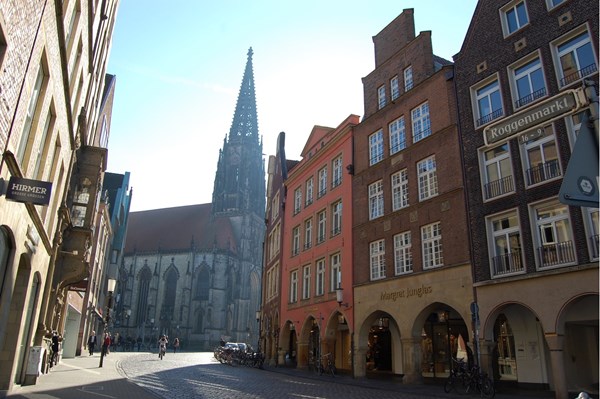
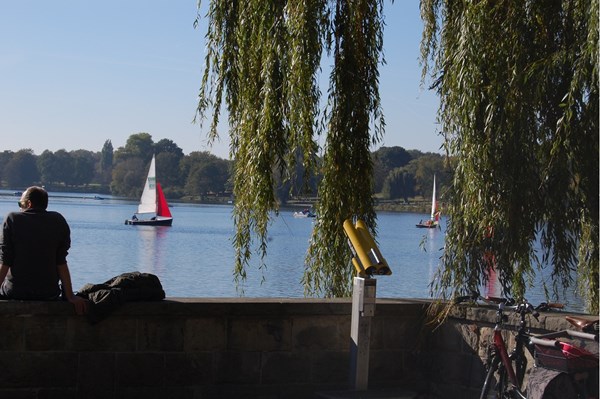
My first day in Münster set the bar high for the rest of my time in the city. My first stop was a visit to Riesenbeck, a little town located about 40 minutes from Münster. Although the town is small, it has a big presence on the equestrian map. It is home to German international show-jumping star Ludger Beerbaum and his equestrian empire which includes his training stables, breeding operation, and the Riesenbeck Internationational Show Facility.
Riesenbeck International is a fairly new facility, but it’s already getting plenty of traffic. There’s an old castle on the premises in addition to a riding club, hotel and, of course, the show grounds and stabling (with 340 box stalls). There are also about 40 kilometers of trails with special sand footing. At the time I visited, they had recently hosted the Riesenbeck International CSI** (show jumping) and also the German Young Rider Championships.
After a visit to a local tack shop, I saw a local riding club in the town of Greven. This “small” riding club was beautiful and well-appointed, but it was also nice to see something that was geared to more average riders like me. This facility had a few separate stables, an outdoor ring, a field with cross-country jumps and two bright and airy indoor arenas, which are referred to as riding halls. The farrier was out the day I was visiting, and the distinctive smell of hot-shoeing reminded me of being home. A private jumping lesson was going on in the outdoor arena.
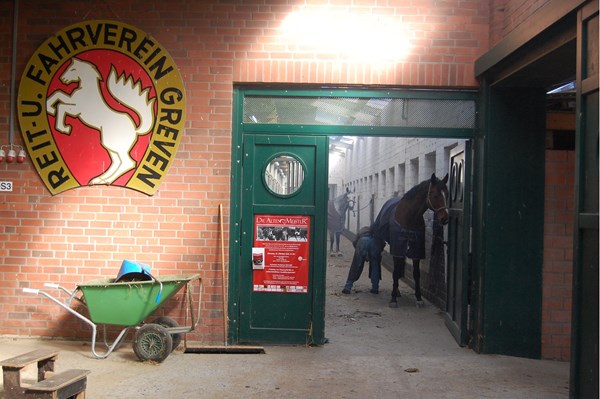
This brings me to another difference I observed in German equestrian culture: There is more focus on producing well-rounded riders. At the lower levels, most riders grow up both jumping and riding dressage. They are not fair-weather riders, either. They hack out on roads in misting rain and gallop in the fields. It seems unusual to find riding clubs that are geared strictly toward one discipline or another. It seems as though people don’t typically specify a discipline until they reach the upper levels and then they focus strictly on dressage or jumping.
The following day, I visited Ingrid Klimke’s farm and then one of the best-known equestrian capitals of the world: Warendorf. This small town, about a 45-minute car ride from Münster, is home to the Deutsche Reiterliche Vereinigung, (German Equestrian Federation), commonly known as the FN, and the Deutsches Olympiade-Komitee für Reiterei (German Olympic Committee for Equestrian Sports), also known as the DOKR. In short, the FN is responsible for promoting equestrian sport and breeding, providing guidance and services and preserving historical data and the DOKR focuses on the training and development of high-performance horses and riders.
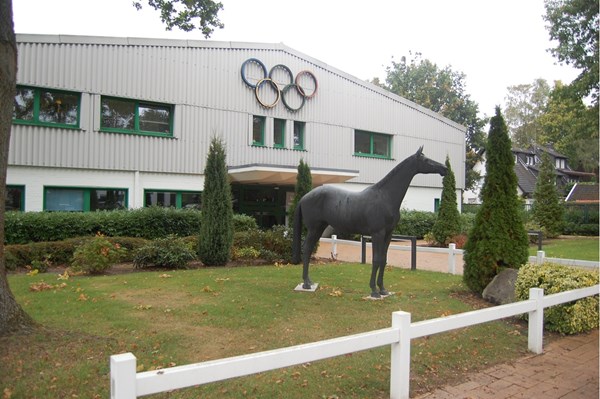
The two organizations are housed in buildings located right next to each other and there is a massive training facility on the property as well. There are stabling and multiple, very large indoor rings. Some riders come temporarily while others are based there more long-term. On the day I walked down the barn aisles, I saw young jumper riders, young dressage riders on ponies and a few members of the German Olympic Eventing Team. Warendorf is like a little village of elite riding.
Hannover
Hannover is a city that I would like to spend more time in and get to know better during my next trip to Germany. During my visit to this town, my sole purpose was to learn about the manufacturing of tack and riding apparel, so I didn’t get to explore the city as much as I did in other places. However, I did learn that Hannover (which was about a two-hour train ride northeast of Münster) has national importance as a home to universities, a medical school, a vet school, the world’s largest fairground and a zoo. If the town’s name (which, of course, brings to mind the Hanoverian breed) has you imagining lush rolling pastures and horse farms, think again, as it actually seems very urban with a big-city feel.
Iserlohn
After a brief detour north to Lübeck and Rostock to visit some dear friends, I made my way back in the direction of Münster, down to a city called Iserlohn. Some special points of interest in Iserlohn include the Dechenhöhle (Dechen Cave), one of the most visited caves in Germany, and the Danzturm, which is a tower that overlooks the old city. I also tried a bit of mustard soup, which is something the region is known for and also something I would highly recommend. While Iserlohn is a little bit off of the beaten path taken by most American tourists, I had a specific purpose. I was there to learn about bitting, right from the source. (See “A Tradition of Quality” below.)
Nürnberg
The longest journey within my trip actually came at the very end as I boarded a train that took me about four hours south to Nürnberg (Nuremburg), a city in northern Bavaria. Whenever I told someone that I was heading to Nürnberg, they gushed about what a beautiful city it was and how much I would love it. They were right. I was mesmerized by the winding cobblestone streets that were lined with medieval architecture. The Nürnberger Burg (Nuremburg Castle) and the famous city walls are medieval icons in Europe and a fairly easy uphill stroll to the castle courtyard can lead you to a beautiful lookout of the city and surrounding area. Nürnberg is also home to several canals with willow trees that gracefully drape over them. For those with an interest in World War II history, Nürnberg is an educational place to visit, as it was the location of several rallies and later, the Nuremburg Trials. However, visitors will discover that period in history is only a piece of the city’s greater story, and there’s an overwhelming amount of beauty to be found there. For example, you can also visit the home of Albrecht Dürer, an important figure in the German renaissance who is known for his paintings and prints.

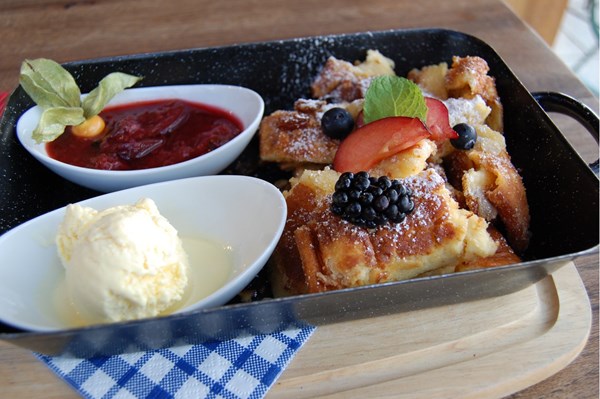
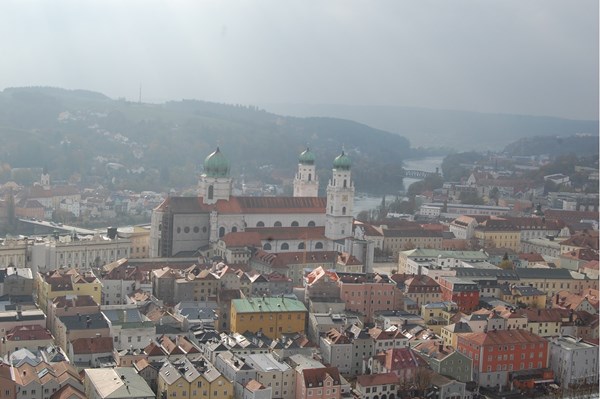
A Tradition of Quality
Throughout the world, Germany has a reputation for producing top-quality horses and riders. Though the horses often steal the spotlight, the country is also home to several major equestrian companies that make the quality equipment that outfits these horses and riders. Throughout my trip, I was able to learn more about a few of these companies, many of which are still family-owned and operated. It is almost impossible to learn about equestrian culture in Germany without encountering the following brands.
During my time in the Münster area, I had a chance to visit the headquarters of Schweizer-Effax GmbH, makers of Effol brand grooming and horse-care products and Effax brand leather care. At the company location in Nordewalde, they do everything from research and development to production and marketing. More than 85 percent of the products are manufactured in-house. They focus on combining innovation with tradition and each product they make is designed to help horse owners grow their friendship with their horses by better caring for them and their equipment. I toured their offices, research labs and factory—all of which reflect German traditions of efficiency and precision. All of the raw materials they use are of the highest purity standards and even the formulas of their animal products must comply with production guidelines that are applicable to human medicine.
G.Passier & Sohn, one of the best-known saddle makers in the world, is based in Hannover, and I was lucky to get a personal, one-on-one tour of the factory with Dirk Kannemeier, the fifth generation member of the Passier family. Dirk is an absolute master of anything saddle related. His whole face lit up as he told me about the rich history of this company that has been passed down from generation to generation since 1867 and has withstood the test of time. You can tell that he simply lives and breathes fine leather and good craftsmanship. Even more impressive is the fact that he is able to explain the elaborate process of saddle-making in very simple terms and in a second language no less. As he showed me each step of the process from start to finish, I learned that saddle-making is an art but also has a lot of science and a good dose of common sense behind it. All of Passier’s saddles are made in house and can be 100-percent customized to fit the needs of horse and rider.
While I was in the Hannover area, I also had the chance to visit the headquarters of Cavallo, a company that many American dressage riders associate with fine riding boots and sportswear. Cavallo was founded in 1978 in Bad Oeynhausen, Germany, and first began manufacturing riding boots. To this day, the boots are still made right at Cavallo’s headquarters, and they have expanded their product range to include paddock boots, half chaps, breeches and other riding apparel.
Herm. Sprenger, a family-owned company located in Iserlohn, began making horse equipment in 1872 and has been perfecting the art ever since. At Sprenger’s factory and headquarters, the original brick buildings are even still in use and they produce almost everything in house. In a private tour from Mr. Sprenger himself, I learned that they even made some of the machines and tools that they use to make their products. This means that when one of their sponsored riders, like Ingrid Klimke or Lisa Wilcox and Ernst Hoyos has an idea for how a bit design can be improved or they need a specific bit for a specific horse, Sprenger can make it. Sprenger has also done a lot of work in partnership with the veterinary school in Hannover to learn more about the actual science of bitting and has applied those findings to their manufacturing process.
Uvex Sports, the German safety-equipment manufacturer, is based in Bavaria with headquarters near Nürnberg. During my time with the company, which produces equestrian helmets, gloves and safety glasses (in addition to skiing and cycling equipment), I got to take a look at helmet development, production and safety testing. Founded in 1898, it is also a family-owned company with the main mission of protecting people. I wear a helmet every time I ride, but it struck me that I hardly knew anything about how one is made. I learned that there is a lot that goes into helmet manufacturing, as it takes approximately two to two and a half years to produce a helmet from scratch and the process of actually converting a design into a reality takes the hands of many people as well as helmet molds, injecting machines, plasma activation, painting, oven-drying, extreme heat, sponge printing, ultrasonic tools and more.
Dressage Today would like to thank each of these companies for generously sharing their knowledge about their products, headquarters and the cities that they call home.
Homeward Bound
After my time in Bavaria, I headed back to Hamburg to catch my plane home. If the horses and people who I love weren’t so terribly far away, I would have gladly stayed longer in the beautiful country of Germany. As I gazed out the airplane window, taking in my last glimpse of it all, I could feel my excitement to ride again bubbling up inside me. It’s nothing less than inspiring to be exposed to some of the very best horses, riders and equestrian facilities in the world and a culture that fully embraces it all. It turns out that my destination was well worth the journey across an ocean—because what I experienced on the other side of the Atlantic was priceless.









